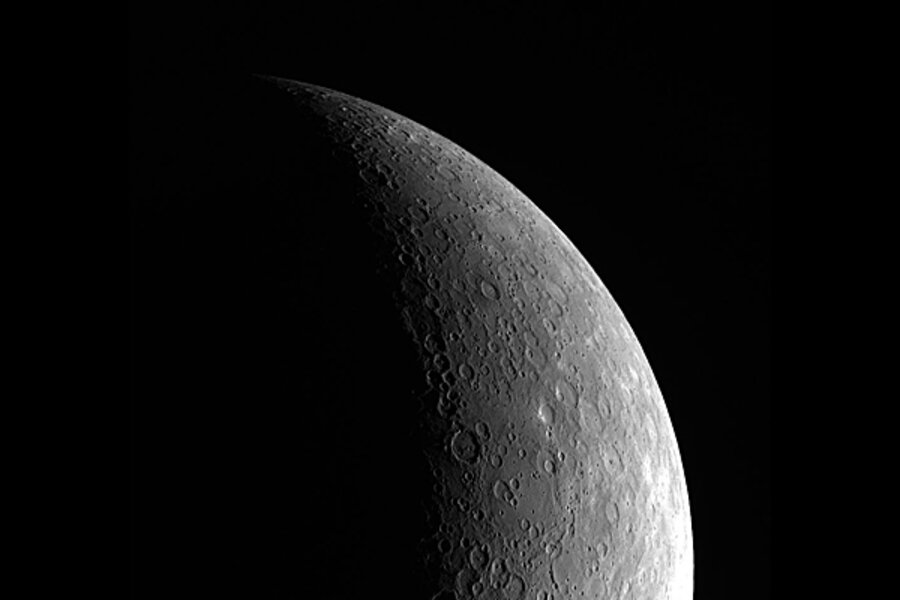Strange features on Mercury upend thinking about 'first rock from sun'
Loading...
From its bizarre multilayer core to its thin crinkly crust, Mercury is revealing itself as a fun house among planets.
New results from NASA's MESSENGER spacecraft reveal craters with tilted floors. In one large basin, half of the basin floor sits higher than the basin's rim. A vast volcanic plain sports a tall, broad lump, with no obvious source for the rise. The planet's interior is dominated by a core structured vaguely like a peanut M&M – a solid-iron center, a molten iron layer, covered with a thin, dense shell. And Mercury's equator traces a slight ellipse, rather than a circle.
All in all, the first spacecraft to orbit Mercury is revealing the planet with many features unlike anything researchers have seen anywhere else in the solar system.
After looking at MESSENGER's data so far, “I understand far less than I used to” about Mercury, says Maria Zuber, a planetary scientist at the Massachusetts Institute of Technology in Cambridge, who leads a team analyzing the planet's surface features. “But I know more.”
One key message: Mercury has been geologically active through far more of its 4.6-billion-year evolution than previously thought.
Mercury is the solar system's munchkin planet – slightly larger than the moon. Given its size, “there was good reason to believe that Mercury cooled off early, and there hasn't been much of anything going on for most of its history,” Dr. Zuber says. But the evidence the team has gathered suggests that the broad, oddly deformed features they see in the planet's northern hemisphere were formed when the planet was well into middle age, she says.
The MESSENGER team unveiled its latest results Wednesday during a four-day planetary-science meeting in Woodland, Texas. The formal research papers are being published this week on Science Express, the online outlet for the journal Science.
Until MESSENGER arrived, only 40 percent of the planet had been mapped, focused on its eastern and western hemispheres. The maps were built from data gathered by NASA's Mariner 10 mission, which conducted flybys of Venus and Mercury. Messenger orbits Mercury's poles, giving full coverage of the planet.
An inside-outside tour the team provides begins with a core once thought to take up some 75 percent of the planet's radius – far larger than the core of any other planet compared with the planet's size. Speculation on the reason for such a large core centers on a collision early in Mercury's history that would have knocked much of its initial crust and mantle off the planet – with enough power to blast the material well out of Mercury's orbit.
Measurements of the planet's gravity field, based on radio tracking of subtle variations in gravity imparted to MESSENGER's orbit over the past year, have revealed a core that takes up fully 85 percent of the planet's radius. Moreover, the measurements were key in revealing a triple-layer core – a probable solid-iron center, surrounded by molten iron, then encased in a shell of iron sulfide.
That came as a big surprise, says Sean Solomon, a planetary scientist with the Carnegie Institution for Science in Washington, D.C., who is the mission's lead scientist.
Indeed, the results were so unexpected that the team didn't hold much stock in the gravity measurements initially. “You wouldn't believe how long we thought we had the gravity field wrong,” Zuber adds.
The iron-sulfide layer ranges from a few 10s of kilometers to 200 kilometers thick. With Mercury's core some 2,000 km thick, and an avergage of perhaps 100 km for the shell, that leaves 200 km for the overlying rock in the planet's mantle, and another 50 km for the crust.
Zuber likens the relative thickness of the Mercury's mantle and crust to the peel on an orange.
Orbiting high above that "peel," MESSEGNER has taken more than 4.3 million measurements with its laser altimeter to reveal unusual features in a broad swath of lowlands high in the northern hemisphere. The plains formed as magma welled up from under the crust and spread over the planet's surface. One section of the lowlands hosts a rise that spans some 950 km and peaks at 1.5 km above the surrounding landscape. It's here that impact craters on its slopes, partially buried in lava, host tilted floors. This indicates that the rise formed after the volcanism that formed the plain itself.
In addition, a feature known as Caloris Basin – a 1,550-km-wide impact crater – shows up at mid-latitudes with the northern portion of its floor rising higher than the crater rim. With MESSENGER's new, global viewpoint, the elevated portion of the floor appears to be part of a long scarp that first appeared in images during the Mariner 10 mission. But those images showed only a small segment of the scarp-like feature. These latest data indicate that the scarp extends for roughly half of the planet's circumference.
The mantle is too thin for processes seen elsewhere, such as with Earth's mantle, to form the scarp.
Carnegie's Dr. Solomon says he and his colleagues strongly suspect the feature may be a case of planetwide shrinking.
“So many of the features we see are a product of horizontal shortening of the crust” as the planet's core has cooled. That cooling and contraction “is greater by a lot than what we see for the other planets.”We're now looking at the possibility that even the changes we see in surface topography are another manifestation of surface contraction.”
To borrow of phrase often used by scientists with NASA's Lunar Reconnaissance Orbiter regarding its surprising revelations about a “boring” moon, MESSENGER is showing that the first rock from the sun “is not your father's Mercury.”







